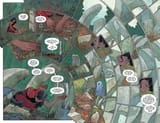Search Results
6/20/2025, 3:27:05 AM
>>149074712
Those extra panels are just indicators for a moment in time, which I think you know.
If the scene you posted were filmed, there are any number of ways you could capture Diana's acrobatics with different cinematography, but they all would have the advantage of filming an actor in motion. They're on a beach front, and she dodges 5 lasers. You could put that into 5 different panels, or even more, but the artist here uses a single panel to show the environment with six illustrations and six panels within the large panel.
If each of Diana's moves were given an entire panel with its own set piece, it would lose the smooth, kinetic movement which is conveyed by the single panel with the smaller illustrations, which is a cartooning technique. The boxes are just stylization and to help separate the action (moments) such that it is easier to read.
It's like what you posted here >>149066994 except that AWW actually looks good.
>It must tell a story through sequential images, if it doesn't do this, it ceases to be a comic and becomes some avant garde art piece.
These two pages in question certainly do that, but to address your point without arguing semantics, I would argue it is more accurate to describe the comics medium as story and artwork magazines rather than necessarily avant-garde work being something else entirely because they do not match arbitrary guidelines. People create and publish all kinds of crazy shit.
I bet you would hate this page also. You would also hate the horror book Gideon Falls. It uses weird paneling to the point of huffing its own farts. I think the kinds of issues you have with creative paneling can definitely go too far. It's a matter of taste. For me, as long as it looks good, and I can tell what's going on, it doesn't bother me too much. My barometer for whether this kind of thing is good or bad is how accessible it is to the reader.
Those extra panels are just indicators for a moment in time, which I think you know.
If the scene you posted were filmed, there are any number of ways you could capture Diana's acrobatics with different cinematography, but they all would have the advantage of filming an actor in motion. They're on a beach front, and she dodges 5 lasers. You could put that into 5 different panels, or even more, but the artist here uses a single panel to show the environment with six illustrations and six panels within the large panel.
If each of Diana's moves were given an entire panel with its own set piece, it would lose the smooth, kinetic movement which is conveyed by the single panel with the smaller illustrations, which is a cartooning technique. The boxes are just stylization and to help separate the action (moments) such that it is easier to read.
It's like what you posted here >>149066994 except that AWW actually looks good.
>It must tell a story through sequential images, if it doesn't do this, it ceases to be a comic and becomes some avant garde art piece.
These two pages in question certainly do that, but to address your point without arguing semantics, I would argue it is more accurate to describe the comics medium as story and artwork magazines rather than necessarily avant-garde work being something else entirely because they do not match arbitrary guidelines. People create and publish all kinds of crazy shit.
I bet you would hate this page also. You would also hate the horror book Gideon Falls. It uses weird paneling to the point of huffing its own farts. I think the kinds of issues you have with creative paneling can definitely go too far. It's a matter of taste. For me, as long as it looks good, and I can tell what's going on, it doesn't bother me too much. My barometer for whether this kind of thing is good or bad is how accessible it is to the reader.
Page 1
